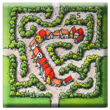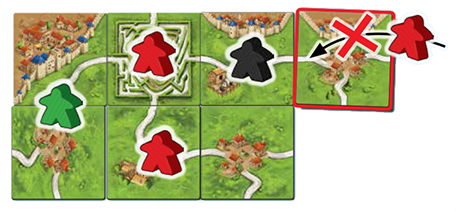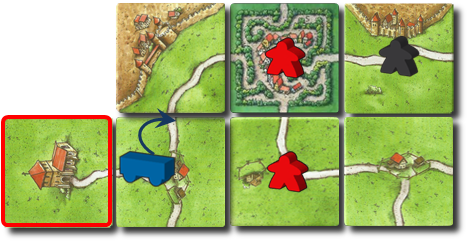Het Doolhof
Algemene informatie en commentaar
Het Doolhof is oorspronkelijk uitgegeven door Spiel Doch! in Template:Year nl.
In de uitgave 1/2016 van het tijdschrift Spiel Doch! staan twee nieuwe tegels voor Carcassonne. De ene is geïllustreerd in de stijl van de 1ste editie van Doris Matthäus, de andere in de stijl van de 2de editie van Anne Pätzke. Beide tegels kunnen in alle edities worden gebruikt. Combinaties met andere uitbreidingen en mini-uitbreidingen zijn niet volledig getest en er zijn geen officiële regels voor dergelijke gevallen.
Spiel Doch! leverde een basisset van regels op en HiG heeft een variant voor gevorderde spelers uitgebracht die beschikbaar was op hun website op het moment van uitgave.
Inhoud
- 2 landschap tegels, een 1ste editie Carcassonne en de andere voor de 2de editie van Carcassonne
Regels
Voorbereiding
Mix de doolhof tegel(s) met de andere landschapstegels.
Het plaatsen van een tegel
Wanneer je een doolhof pakt, plaats je deze volgens de normale regels.
Het plaatsen van een meeple
Basis regels
When you place a labyrinth tile, you are allowed to put a meeple on it (also in compliance with the standard rules). The labyrinth is not a crossing; all outgoing roads are interconnected. Consequently, a meeple can only be placed on it if all the roads connected to the labyrinth tile are unoccupied. [1] The meeple then is a thief on all the connected roads.
Uitgebreide variant
Since the labyrinth makes the connections of the roads quite unmanageable, the placing of meeples is regulated differently in this variant. If you place the labyrinth, you may place a meeple on it even if there is already a meeple on one or more connected roads. [2] It does not matter who owns those meeples.
Naarmate je verder komt in het spel, als je een tegel plaatst bij de uitgang van het doolhof, waar nog geen meeple heeft, kun je daar een meeple plaatsen; hoewel het netwerk van wegen dat aan het doolhof vast zit wel meeples kan bevatten.
Als je een weg aan een al bestaande weg plaatst met een meeple erop, mag hier geen meeple meer bij geplaatst worden(zoals gebruikelijk). Het doolhof en de vier aangelegen uitgangen zijn uitzonderingen op de regels.
Het scoren
Basis regels
De doolhoven worden gescoord zoals de normale wegen van Carcassonne.
Uitgebreide variant
Het scoren van een project
The labyrinth and the connected roads are scored when all 4 of the roads are completed. The player with the majority of meeples on the labyrinth and the connected roads will get 1 point for each tile as usual. In addition, he or she will get 2 points for each meeple standing on the labyrinth or on a connected road. If several players have the majority, each of them gets the full number of points.
De eindtelling
The labyrinths are scored according to the normal Carcassonne rules for roads. You get no additional points from the meeples placed on the labyrinth network.
De interacties met andere uitbreidingen
This section summarizes the interaction of The Labyrinth with other expansions:
These interactions are described as a series of cases where the points you get from the road tiles (including the labyrinth) vary depending on the expansions involved. Independently of how these points are modified, if playing with the advances rules, the bonus points for the meeples on the road do not change in any case when scoring the feature.
- Case 0 - Regular labyrinth: If a labyrinth is completed, you will get 1 point for each road tile including the labyrinth itself. An incomplete labyrinth at the end of the game is worth 1 point for each tile including the labyrinth itself.
- Case 1 - Inns & Cathedrals: If a labyrinth is completed and contains one or more inns (inns do not stack) and you have the majority of meeples, you will get 2 points instead of 1 point for each road tile including the labyrinth itself. An incomplete labyrinth with an inn(s) at the end of the game is worth 0 points for each tile including the labyrinth itself.
- Case 2 - German Cathedrals: If a labyrinth is completed and one or more of its roads end at a German Cathedral (German Cathedrals do not stack) and you have the majority of meeples, you will get 2 points instead of 1 point for each road tile including the labyrinth itself. An incomplete labyrinth with one or more of its roads ending at a German Cathedral at the end of the game is worth 1 point per tile including the Labyrinth itself.
- Case 3 - Inns & Cathedrals + German Cathedrals: If a labyrinth is completed and contains one or more inns and one or more of its roads end at a German Cathedral and you have the majority of meeples, you will get 3 points instead of 1 point for each road tile including the labyrinth itself. An incomplete labyrinth with an inn(s) at the end of the game is worth 0 points.
The following table describes the same information in a more schematic way. Take into account that road segments on German Cathedral tiles are counted separately and get the same points as any road tile in Cases 2 & 3.
| Scenario | Regular Labyrinth | Inns and Cathedrals | German Cathedrals | Scoring a feature | Final scoring |
|---|---|---|---|---|---|
| No other expansions involved | There are one or more inns on its roads (inns do not stack) | One or more of its roads end up at a German Cathedral (German cathedrals do not stack) | You have meeple majority of the completed labyrinth | You have meeple majority of the incomplete labyrinth | |
| Points from road tiles including the labyrinth (road segments on German Cathedral tiles are counted separately in Cases 2 & 3) | |||||
| Case 0 | X | 1 point / tile | 1 point / tile | ||
| Case 1 | X | 2 points / tile | 0 points / tile | ||
| Case 2 | X | 2 points / tile | 1 point / tile | ||
| Case 3 | X | X | 3 points / tile | 0 points / tile | |
| Other modifiers applicable following the order of evaluation (German Cathedral tiles are counted as normal tiles) | |||||
| Mage on the road | Any | Any | Any | (+1) point / tile | (+1) point / tile |
| Witch on road | Any | Any | Any | 1/2 points (rounded up) | 1/2 points (rounded up) |
| Meeple on Wainwrights Quarter (Markets of Leipzig) | Any | Any | Any | (+1) point / tile | (+1) point / tile |
| Points from meeples placed on road tiles and the labyrinth (advanced rules only) | |||||
| All cases | Any | Any | Any | 2 point / meeple | 0 point / meeple |
Tegel distributie
Totale aantal tegels: 2
Voetnoten
Ga voor licentie en uitleg over de pictogrammen naar de pictogrammen pagina.
- ↑
 A meeple can be placed on an incomplete labyrinth network by other means if unoccupied: a wagon can move from a completed neighboring feature or a flier can land on any tile of the labyrinth network or a meeple can be placed through a magic portal.
A meeple can be placed on an incomplete labyrinth network by other means if unoccupied: a wagon can move from a completed neighboring feature or a flier can land on any tile of the labyrinth network or a meeple can be placed through a magic portal.
- ↑
 A meeple can be placed on an incomplete labyrinth network by other means: an unoccupied labyrinth tile or road segment can be occupied by a wagon moving from a completed neighboring feature or by any meeple via a magic portal or a flier.
A meeple can be placed on an incomplete labyrinth network by other means: an unoccupied labyrinth tile or road segment can be occupied by a wagon moving from a completed neighboring feature or by any meeple via a magic portal or a flier.









